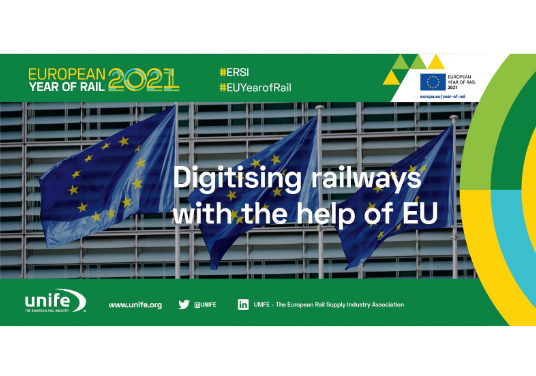Boosting Railway Digitalisation thanks to EU research and innovation
As it is becoming increasingly evident that digital connectivity is changing the current transport landscape and its continued development is expanding the demand for mobility, UNIFE held a digital event on 27 April, as part of its year-long 2021 European Year of Rail discussion series, to explore with EU decision makers and high-level industry leaders the impact of European Research and Innovation (R&I) on the continuing implementation of digital tools in European rail transport.
Fostering a digital transformation is needed more than ever, placing it high in the EU's political agenda and leading policymakers to identify it as critical in unlocking future growth in Europe. These high-tech components will be central to reaching the European Green Deal and Sustainable Development Goals’ ambitions. A digital transformation for railways will also increase capacity, reliability and comfort, while maintaining the EU’s leadership in rail transport equipment manufacturing and services.
The European Year of Rail is a unique opportunity for the continent’s rail supply industry to demonstrate how digitalisation and automation are key drivers for the development of a technologically-driven rail transport system that connects Europe. These cutting-edge tools are essential enablers of the rail sector’s vision, as presented in the prescient documents published by the the European Rail Research Advisory Council (ERRAC), notably the Rail Strategic Research and Innovation Agenda (SRIA).
R&I has been pivotal in rail’s pursuit of a digital transformation. The collaborative-research model established by the Shift2Rail Joint Undertaking is a key success for the rail sector and its successor programme within Horizon Europe, Europe’s Rail Joint Undertaking (ERJU), will enable all elements of the sector’s innovation ecosystem to work together on “Digital Game Changers” that will accelerate the transformation of European rail transport.
Convening a panel composed of representatives from European Commission, Shift2Rail Joint Undertaking, SNCF and Hitachi Rail STS, participants debated on the role of European R&I in accelerating rail transport digitalisation, which is key for increasing its attactivity, capacity, reliability and overall performance. The panel, moderated by International Railway Journal Editor-in-Chief Kevin Smith, agreed that European R&I and collaboration between European rail stakeholders through institutionalised partnerships, such as Shift2Rail Joint Undertaking and the future Europe’s Rail Joint Undertaking, has been influential in achieving impactful breakthroughs on next generation, sustainable transport solutions. Continuing, and deepening, these innovative endeavours are of paramount importance to achieving the “digital leap” required to position rail as the backbone of the mobility of the future.
John Cleuren, Senior Expert, Clean Planet - Future Urban & Mobility Systems at European Commission Directorate-General for Research and Innovation (DG RTD), reflected: “One of the key aspects of ERJU will be to use the good experience of Shift2Rail to achieve the full digitalisation of the railways in years and not decades”.
Carlo Borghini, Executive Director of Shift2Rail Joint Undertaking, stated in his intervention that: “Through Shift2Rail’s R&I programme, and its continuation under its successor, the rail sector can come together to exploit the full potential of digitalisation, automation, telecoms and satellite services, to transform the rail system by making it the sustainable, interoperable backbone of mobility and transport in Europe”.
Christophe Chéron, Shift2Rail coordination and European partnerships at SNCF and ERRAC SRIA Leader, commenting on the impacts of digitalisation on rail transport and the role of R&I: “Digitalisation is key for making the railway mode more adaptative to meet the need of mobility. Common investments for research and innovation in the Europe’s Rail partnership will accelerate the way towards the rail being a backbone of mobility”.
Antonella Trombetta, Head of European Affairs at Hitachi Rail STS and Shift2Rail Innovation Programme 2 Steering Committee coordinator, added: “Digitalisation and standardisation are key for building-up a future innovative and competitive rail transport. The new Europe’s Rail Joint Undertaking shall help the European rail sector to achieve its digital transformation”.
Philippe Citroën, Director General of UNIFE, concluded the event by saying: “A digital transformation of the European rail system can only happen with the launch of bigger rail research and innovation initiatives that give the European rail sector the ability to increase capacity, attractiveness, and reliability. Europe’s Rail Joint Undertaking will be a catalyst in positioning rail as the backbone of mobility and achieving EU Green Deal objectives”.
Watch the webinar recording here.
More information
Andrei Ciufu
Head of UNIFE Communications
andrei.ciufu@unife.org
+32 (0)2 626 12 64
Twitter | LinkedIn | Vimeo
